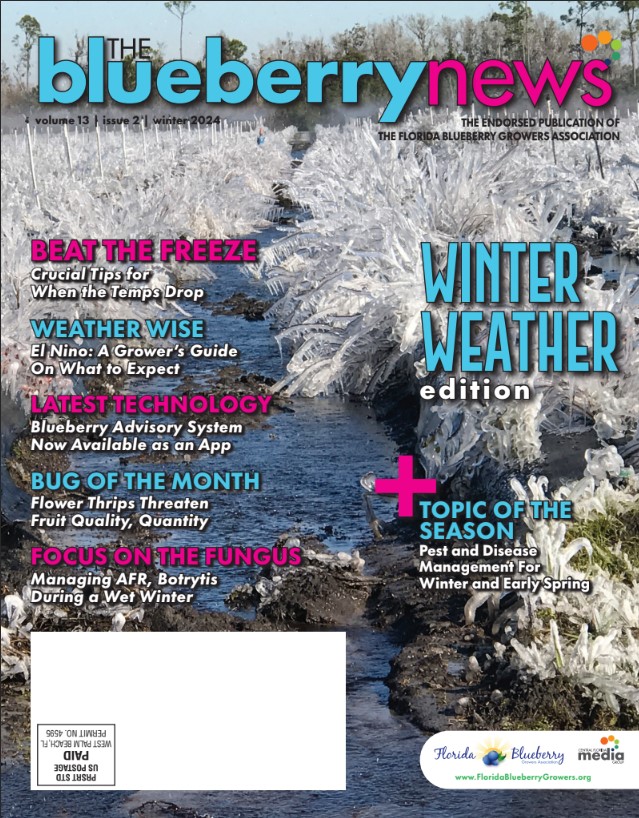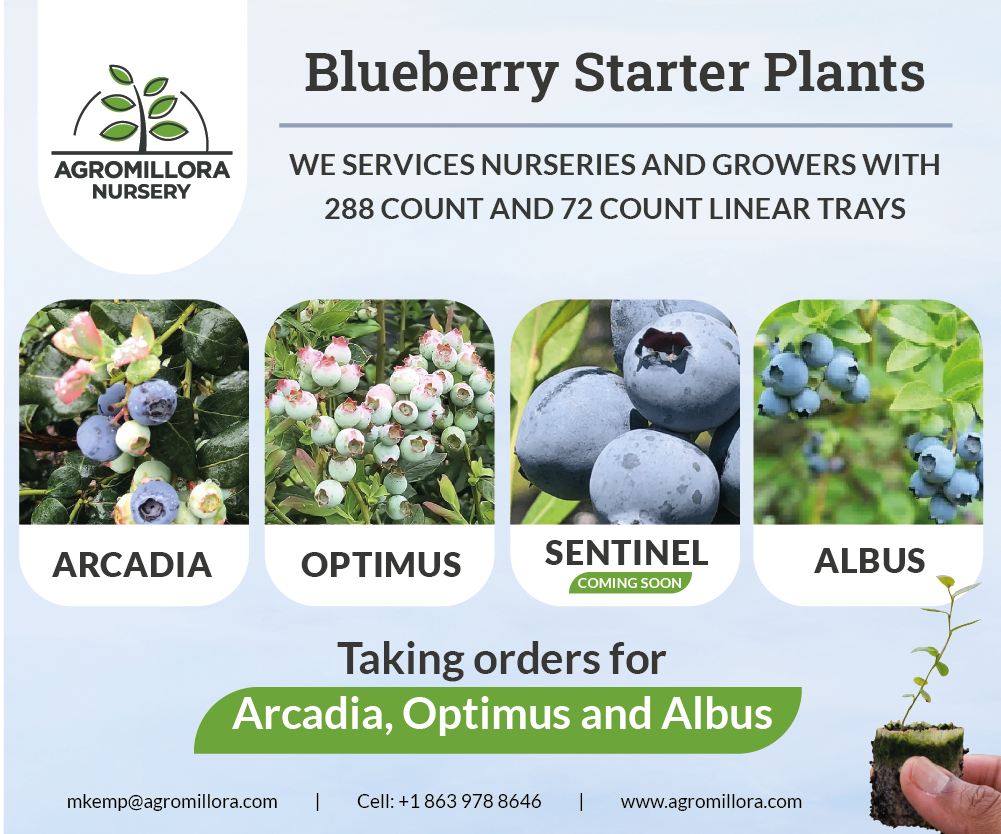The Best Practices for Blueberry Pollination Might Not Be What You’d Expect
Honey Bees
Managed European honey bees (Apis mellifera) are the most frequently used pollinators in commercial blueberry fields. They are usually rented to growers in hives containing 10 frames. Sufficient numbers of honey bees will typically result in good pollination for southern highbush blueberries. However, they are not as effective as some of the other pollinators discussed below, and their contributions to pollination can be affected by things like competing flowers in the surrounding landscape or weather. Honey bees are not capable of sonicating, a pollen collection strategy used by bees to increase pollen release by flowers. Honey bees are also more likely to collect nectar when foraging on blueberry flowers as compared to other pollinators that collect both nectar and pollen. The combination of these factors is among the primary reasons that honey bees are less effective in pollinating blueberries as compared to some pollinators, but large numbers of these bees in fields can compensate for lower efficacy.
Bumble Bees
Bumblebees (Bombus spp.) (Figure 1) are very effective pollinators of blueberries, due in large part to their ability to increase pollen shed by sonication (rapid wing movement to vibrate the flower). A bumblebee can pollinate as many as six blueberry flowers in the time it takes a honey bee to pollinate a single flower. In addition, bumblebees will continue to forage in cooler, windy, or overcast conditions, as well as later in the day, and show an overall higher attraction to blueberry flowers. Growers may want to consider adding bumblebee hives to their fields as a hedge against poor weather during bloom, or other conditions that result in lower activity by honeybees. Managed bumble bee hives are sold in containers called quads, which contain four colonies. Bumblebee quads may be a more expensive option than honey bee hives, however, some growers experience challenges using both honey bees and bumblebees simultaneously, with honey bees robbing bumblebee colonies and weakening them. Unlike honey bees, bumblebee colonies will only be active for up to 8 weeks before the colony dies, so be sure to time their placement to effectively cover the bloom period.
Figure 1. Bombus pensylvanicus, the American bumblebee.
Credits: R. Mallinger, UF/IFAS
Native Pollinators
There are a few wild blueberry pollinators present in Florida, including wild bumble bees (Bombus spp.), carpenter bees (Xylocopa micans and Xylocopa virginica) (Figure 2), and the southeastern blueberry bee (Habropoda laboriosa) (Figure 3). The southeastern blueberry bee is a blueberry specialist, highly attracted to blueberries, and sonicates the flowers for increased pollen shed. However, these bees emerge late in the southern highbush blueberry bloom cycle, so they may not be present during full bloom for many cultivars. Carpenter bees prefer to make a slit in the corolla to remove nectar and pollen and are therefore not as effective as pollinators since they do not make sufficient contact with the flower’s reproductive parts.
Figure 2. Xylocopa virginica, the eastern carpenter bee.
Credits: R. Mallinger, UF/IFAS
Figure 3. Habropoda laboriosa, the southeastern blueberry bee.
Credits: R. Mallinger, UF/IFAS
Managed Hive Density
The current recommendation for honey bee stocking density is 3 to 4 hives per acre for a standard density blueberry planting (around 1,700 plants). Growers should observe 4 to 8 honey bees foraging per bush during peak bloom in the warmest part of the day to ensure there are sufficient pollinators in the field. For managed bumblebees, the recommendation is one quad (four colonies) per acre. Research is ongoing by the University of Florida to determine whether these recommendations will change in the future. Increased stocking densities may be needed for high-density plantings, concentrated bloom during warm weather, or where there are other flowering crops or wildflowers that may compete for bee foraging.
Timing and Placement
Honey bee and bumble bee hives should be placed in the field when there is at least 10% bloom (so bees won’t begin to forage elsewhere) but no more than 20% bloom in order to receive adequate pollination across the farm. Once a blueberry blossom has opened, it will only be receptive to pollen for 3 to 5 days, so it is important to have sufficient bees in the field to pollinate the crop during the bloom period.
Ideally, hives should be distributed throughout the farm and as close as possible to blueberry rows without impeding normal production operations. Hives should be placed facing east or southeast with exposure to early morning sun and protected from strong winds. Bumble bee hives should be placed at least 25 feet from honey bee hives to reduce potential interaction between them, and on palettes or other structures to ensure that they aren’t flooded by standing water. Additionally, an “A-frame” structure or sunshade should be placed over the top of the quad to reduce the amount of direct sunlight it receives.
Hive Health
An important factor in facilitating good pollination is making sure hives delivered to the field are healthy, and remain healthy throughout the bloom period. For honey bee hives, at least eight of the typical ten frames should be covered by adults (Figure 4), and at least six with brood in the cells, with steady activity into and out of the hive. Due to the large number of foragers in a hive, at least 20 honey bees observed entering or exiting the hive in a 1-min period during mid-day and good weather can indicate sufficient hive quality. There should also be steady activity into and out of bumble beehives. However, bumblebee colonies are much smaller than honey bee colonies and foragers are active across longer periods of the day, so adequate activity levels will be significantly lower than those observed for honey bees during assessments. To assess bumble bee activity, plan to spend at least 15 minutes watching the hive entrance. Alternatively, to get an adequate picture of the pollination services you are receiving from honey bees and bumblebees, we recommend walking down a row in peak bloom and tallying the number of honey bees and bumblebees seen on flowers (be sure to only record those bees actually visiting flowers). Given the higher efficacy of bumblebees, one visit by a bumblebee may equate to 5+ visits by honey bees.
Protecting bees from the effects of insecticides is essential to the continued health of the colony. In addition to only using insecticides where and when the label indicates they are safe to use while bees are present on the farm, spray applications should be made in the late afternoon or evening when the bees are no longer foraging in the field, leaving sufficient time for the product to dry before foraging resumes the next morning. Some growers also cover the hives with tarps while they are applying insecticides.
Figure 4. Adult honey bees on a hive frame.
Credits: UF/IFAS
For additional information see UF EDIS Publication ENY-172, Pollination Best Practices in Southern Highbush Blueberry in Florida (edis.ifas.ufl.edu/pdffiles/IN/IN123700.pdf) and Do More Bees Mean More Berries? A Blueberry Pollination Research Update (https://bit.ly/3rKYVyf).
DR. RACHEL MALLINGER, ASSISTANT PROFESSOR, DEPARTMENT OF ENTOMOLOGY AND NEMATOLOGY, UF,
JOHN TERNEST, PH.D. STUDENT, DEPARTMENT OF ENTOMOLOGY AND NEMATOLOGY, UF,
& DOUG PHILLIPS, BLUEBERRY EXTENSION COORDINATOR, UF





